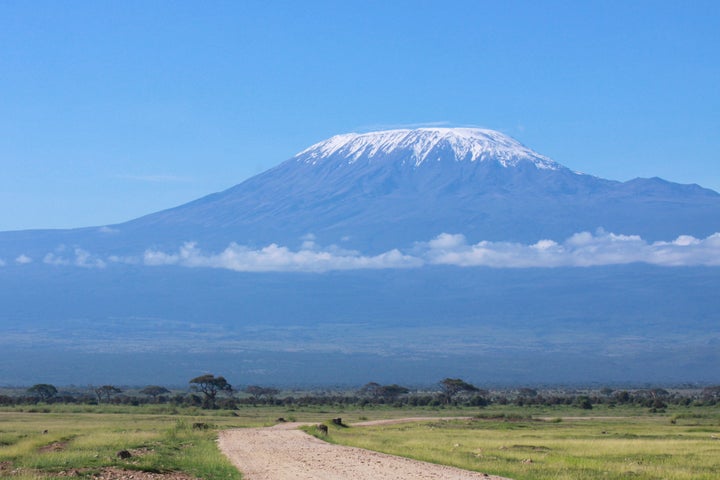
Why so many conflicting headlines? There are two main reasons. First, the mainstream media tends to follows whatever seems controversial and catastrophic. So the facts often come much lower down in the story than the dramatic headline. If you actually read the articles, the climate scientists quoted inevitably mention the 99.9% consensus among experts: that human caused climate change is occurring. Some scientists are concerned that environmental advocates oversimplify the issue. They claim more that hard science can prove, and that ends up playing into the hands of climate deniers (who are more often than not paid pundits, rather than climate scientists). But when scientists attempt to explain the nuances of the mountain, the media too often gets it wrong and misreports.
For example, Philip Mote. the University of Washington scientist quoted in the Seattle Times article above, "Kilimanjaro not a victim of climate change," is so concerned about the reality of climate change he travels the Northwest to warn of global warming's regional impacts. He just thinks Kilimanjaro is a problematic example.
The second reason is the actual complexity of what is happening on Kilimanjaro. There are many forces driving the climate of East Africa all at once. The media likes to draw a straight arrow between cause and effect. Scientists, on the other hand, spend their time seeking ways to disprove a causal link, and they are very reluctant to make any claims of causality that have not been thoroughly tested. The big problem with measuring Kilimanjaro's climate is the lack of high-altitude data in East Africa. There's no baseline against which to measure changes of temperature and dryness. This makes it hard to establish historical trends.
Ironically, Kilimanjaro's glaciers are now the source of historical climate data. Research teams have drilled ice cores which can be read like tree rings. Bubbles of air trapped in the layers of frozen ice reveal a wealth of data about the climate of Kilimanjaro over the past 11,700 years -- the age of the bottom layers of ice. It's like discovering the geological equivalent of the Dead Sea Scrolls. Sadly, this record is on its way to being erased as the glaciers disappear. In fact, in some places the top layers have begun to melt -- literally wiping the data from the most recent parts of the record.
- Kilimanjaro's glaciers are at least 11,700 years old. Over 150 years ago, when the first European visitors documented Kilimanjaro's appearance, the volcano's cone was covered with a thick crust of ice. About 90% of this ice has since vanished. This loss of ice predates the start of human-caused climate change by several decades.
- The rate of glacier shrinkage has doubled since the 1970s -- when human caused climate change kicked in. All over the world tropical glaciers are receding, as indeed most are in all latitudes. The fact that these 11,700 glaciers are on their way to completely vanishing within 20 years marks a significant change in East Africa's climate.
- Technically, the glaciers are not melting. They are evaporating -- turning directly from ice to vapor through a process known as sublimation. The air is below freezing at the summit, but the sun excites water molecules in a way similar to how dry ice evaporates at room temperature.
- Increased dryness may be the key driver of glacier shrinkage. East Africa has been getting less and less moisture, so new snow is not replenishing the glacial ice lost to sublimation. A few seasons of new snow can in fact build back some of the ice, as the Turbo News article reported in 2011). If the drying trend lasts (together with the increased sunlight), the glaciers are still doomed.
- Increasing dryness in East Africa (the cause of droughts and famines in Kenya, Ethiopia, and Sudan), may in fact be speeding up due to global climate change, especially by altering air patterns over the Indian Oceans. (This is the hypothesis most the knowledgeable people I have spoken with or read think is the likely cause of Kilimanjaro's dwindling glaciers).
Here is the article of the original findings the Kilimanjaro research team published in the Proceedings of the National Academy of Sciences, November 2009.
Here's a CNN report on the same research.
There is a second driver of local climate change on Kilimanjaro -- deforestation. But according to the most recent research this is only affecting lower elevations. While this is deadly serious -- over a million people depend on the rainfall and rich vegetation on Kilimanjaro's green slopes -- scientists who are studying this effect have not found any evidence this is affecting the glaciers. The glaciers are at an altitude high above the cloud forests where these local changes are being seen and studied. More on that in a future blog post.
Tim Ward is the author of Zombies on Kilimanjaro: A Father-Son Journey Above the Clouds. The book includes a discussion of climate change on the mountain, reflections about why climate change is so difficult for scientists to communicate, and an attempt to explain why humanity is doing such a poor job of grappling with this potentially catastrophic issue.
